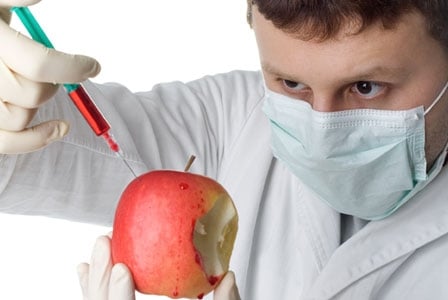
An Okanagan company is seeking approval from the Canadian Food Inspection Agency and Health Canada for their genetically modified \”Arctic\” non-browning apple.
Do you hate it when your cut-up apple turns brown? Do you hate it enough to eat a genetically modified apple that will never turn brown? It’s what a biotechnology company based in the heart of BC’s Okanagan apple-growing country is hoping.
The company has filed for approvals from the Canadian Food Inspection Agency and Health Canada to release the genetically modified (GM) apples here for “commercial planting purposes, livestock feed, and food use.” They’ve also filed for approval with the US Department of Agriculture and have already started establishing test blocks of the trees with commercial partners in the US.
GM apples help business—not consumers
The company has spent more than a decade developing their “Arctic” apple which has been genetically engineered to be non-browning. Their website focuses on the cost to industry supply chains as the chief reason for developing this new technology.
Do we really need our apples cut up for us?
The company is banking on the “yuck factor,” as they call it on their website, to market this new GM food to the masses. Their target market is the value-added food industry where the apples will be cut up and packaged for sale at restaurants and other food service retailers.
Golden Delicious and Granny Smith
Only two varieties have been developed so far (these are the subject of the approvals the company is awaiting): the Golden Delicious and the Granny Smith. They are also developing non-browning versions of Gala and Fuji apples.
Plans for GM peach, cherry, and pears, too
The Okanagan company also has plans to use their technology to produce other GM tree fruits, including varieties of peach, cherry, and pear. Their technology switches off the gene that controls the enzyme, called polyphenol oxidase (PPO), that reacts to oxygen when the fruit is cut or bruised. This reaction leads to the browning effect.
How will you know you’re eating a GM apple?
You won’t. Unless, of course, you happen to know that a label that reads, “Arctic apple,” means that you’re about to cut into a non-browning GM apple.
No mandatory labelling of GM foods
Canada does not require the mandatory labelling of genetically modified foods, though at least 40 countries around the world have mandatory labelling laws, including Europe, China, and Russia.
A national voluntary labelling standard was established, but, according to the Canadian Biotechnology Action Network (CBAN), no company has yet labelled their products as containing GM ingredients.
Fruit growers are worried about GM apples
Other fruit growers in Canada as well as the US, particularly apple growers, are worried about the negative effects on their industry if the GM apple is approved. Last year the BC Fruit Growers’ Association passed a resolution against the introduction of GM fruit, stating concerns about consumer backlash and the difficulty of protecting organic growers from contamination.
What can you do?
- Learn more about “Arctic” apples.
- Learn more about genetically modified foods.
- Tell CFIA what you think about the “Arctic” apple before July 3, 2012.
How to prevent your apple from browning
- Choose apple varieties known to brown less slowly, such as Ambrosia.
- Submerge cut apple in water to prevent the enzyme (PPO) from accessing oxygen.
- Coat cut apples in sugar or syrup to reduce the amount of oxygen that reaches the exposed skin.
- Coat in lemon, orange, or pineapple juice, which naturally contain antioxidants that help slow down browning.
- Bite into a whole apple and eat the whole thing!



